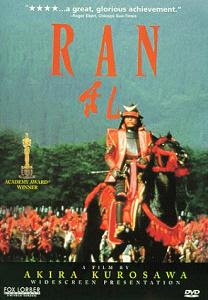
Ran is an easy recommendation even if you've seen many of Akira Kurosawa's masterpieces in black and white. For Ran is arguably his greatest achievement in color. And although his black and white movies are among the best films ever made, seeing a Kurosawa work in color is a significant experience on its own. Ran is not only shot in color, it is colorful. It's long and exhausting but memorable and beautiful. It offers expert direction and cinematography. It's rich of splendid costumes and it's visually gorgeous. Ran is not the lightest movie for watching. Despite its occasional funny moments, the film is sad and painful but like any creation of a true master, every second is worthy of your attention.
Ran is Akira Kurosawa's version of Shakespeare's King Lear. Yet there are many differences between the film and William Shakespeare's play, especially in the details. The setting is Japanese and the specific language style of Shakespeare is missing. The story is about the elderly Lord Hidetora Ichimonji who decides to abdicate and make room for his sons. He wants to give a castle to each three of them while only keeping the title of the Great Lord for himself. But the youngest son Saburo warns the Lord about the threat he should expect of his older brothers Taro and Jiro. The father neglects the warning and banishes Saburo. Soon, it appears that the youngest son has been right.
Ran depicts the often happening in reality drama of envy, revenge and kinship rivalry. The brothers are not the only plotters here. The movie also involves a vindictive woman, Lady Kaede, the spouse of the oldest son, whose family and possessions have been destroyed by the Great Lord. Contrary to her, Lady Sue, the wife of the second brother is peaceful and not hostile despite having the same (if not worse) fate as Lady Kaede. Surprisingly, Lord Hidetora has a hard time through both of his daughters-in-law. The first brings him havoc, the second remorse.
Lord Hidetora Ichimonji has a court fool who is of course funny but simultaneously possesses his own wisdom and often suffers not less than his master. Ran is discouraging movie. The hope and the good deeds although not entirely missing are almost lost in the web of factitious human relationships, guilt, retribution, punishment, betrayal, humility and suffering. The freshest air is coming from the magnificent scenery and the exuberant use of colors. The colors are not only eye-catching but also utilized to make the characters and factions more distinguishable.
There are a few very minor issues with the movie that could be easily omitted. Instead I prefer to mention two other subjects. I don't know if presence of jesters has been common in Japanese courts so it is possible that Kyoami (Hidetora's fool) is a bit out of place in the Japanese setting of Ran. Nevertheless, Kyoami adds a very distinct flavour to the movie and he is one of the characters that stick to your mind. On the other hand, the youngest son's language in the initial scenes with his father is a bit harsh but I suppose this is not so unnatural in Japan where even the normal Japanese talking often sounds like coming from people who are in the middle of a quarrel.
The movie demonstrates ones again that those who speak the truth are not welcome and people prefer listening to lies and flattering. The masterful presentation of this and other sides of life makes Ran a classic film. It is a great achievement by a great director and everyone who is serious about movies should see it at least once.



0 comments:
Post a Comment